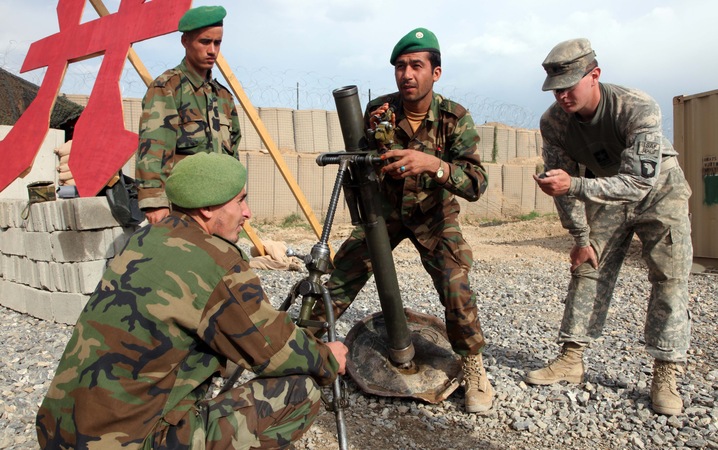A Competing Risks Approach to Security Sector Assistance for Fragile States
Editor's Note: Helping other countries' militaries and intelligence services is a vital part of whatever we're calling the war on terrorism these days. These programs, however, are often seen as one of two extremes: a panacea or an afterthought. Steve Watts of RAND calls for treating these programs with the analytic seriousness they deserve. He notes the range of potential problems and recommends using risk assessments to think about security sector assistance in a more sophisticated way.
***

Published by The Lawfare Institute
in Cooperation With

Editor's Note: Helping other countries' militaries and intelligence services is a vital part of whatever we're calling the war on terrorism these days. These programs, however, are often seen as one of two extremes: a panacea or an afterthought. Steve Watts of RAND calls for treating these programs with the analytic seriousness they deserve. He notes the range of potential problems and recommends using risk assessments to think about security sector assistance in a more sophisticated way.
***
Security assistance (or, according to current U.S. government parlance, “security sector assistance”) to weak and fragile states is one of the most contentious issues in U.S. national security policy today. Fighting the Islamic State and Al Qaeda without a large-scale U.S. troop deployment requires the help of partner governments. Unfortunately, nearly all of these regimes are weak, have poor human rights records, or both. How, then, should the U.S. government balance the risks of cooperating with such troubling governments against the risk that the Islamic State or similar groups could gain strength in these places?
Answers to this question (and ones popular on this blog) can be captured in two mantras: “governance first” and “do no harm.” By this logic, good governance – or at least “good enough governance” – is a precondition for effective security assistance. Without effective governance, regimes will not make effective use of security assistance or, worse, misuse it, abusing portions of their own populations or otherwise undermining their regime. From this perspective, only decently governed partners deserve security assistance.
Much is right about this perspective, but it overestimates the chances of U.S. assistance making a situation worse (rather than simply being ineffective) and the likelihood of the United States finding suitable partners in many critical regions of the world. It also underestimates the potential costs of U.S. inaction and – most importantly – frames as a dichotomous choice what is better understood as a spectrum of competing risks. Instead of following inviolable principles (e.g., “governance first” versus “security first”), U.S. decision-makers should acknowledge the various trade-offs at stake and undertake a more explicit risk assessment before committing to providing security sector assistance.
Instead of following inviolable principles (e.g., “governance first” versus “security first”), U.S. decision-makers should acknowledge the various trade-offs at stake and undertake a more explicit risk assessment before committing to providing security sector assistance.
The Potential Risks Posed by Security Sector Assistance to Fragile States
Security sector assistance might prove destabilizing for fragile states in five ways.
First, large-scale security sector assistance poses some risk to civil-military relations in poorly governed states. Such assistance can potentially insulate a regime from legitimate expressions of discontent by strengthening “praetorian guards” loyal to the regime rather than the state. It can also potentially strengthen military actors at the expense of civilians, thus either increasing the risk of coups or giving the military an unhealthy degree of influence in politics.
Second, security sector assistance can shift the balance of power between ethnic, religious, or other communities by steering resources to some at the expense of others. Such shifts in the balance of intercommunal power – or the perception of such shifts even where U.S. security sector assistance actually is quite modest – can be destabilizing.
Third, as the recent example of Yemen has dramatically illustrated, U.S. military aid can wind up in the hands of the militants the United States seeks to combat. Even non-material assistance such as training can wind up strengthening non-state actors, such as when U.S-trained soldiers defect to militants or join gangs or drug cartels.
Fourth, the United States can wind up abetting abuses by a partner government, either because the government gains new capabilities for repression or because elements of the partner government perceive their close relationship with the United States as a “green light” to attack militants in whatever manner they choose.
Finally, U.S. security sector assistance poses some risk of moral hazard. If a partner government receives large amounts of U.S. assistance solely because it is a good partner in combating terrorism, then it may have incentives not to solve the problem that generates so much aid.
Evidence of the Risks Posed by Security Sector Assistance
The destabilizing dynamics described above, however, are only potential risks. How often do they actually occur? Considering the sums of money involved and the highly contentious political debates surrounding the issue, there are surprisingly few rigorous evaluations of security sector assistance. For now, we must base our judgments of frequency on only a handful of quantitative analyses.
[T]he weakest and most autocratic states experienced no improvements in stability as a result of U.S. security sector assistance.
Perhaps the broadest statistical analysis of the effects of security sector assistance was one undertaken by several of my colleagues at RAND. It found that U.S. investments in security cooperation were associated with reduced fragility around the world. The aggregate effect was relatively small, but it was statistically significant. This finding, however, came with a number of caveats. First, the quality of governance in partner nations mattered a lot; the weakest and most autocratic states experienced no improvements in stability as a result of U.S. security sector assistance. Second (and closely related to the first), there was considerable regional variation, with partners in Latin America, Europe, and East Asia benefiting the most from U.S. assistance, while partners in Africa and the Middle East experienced no gains in their stability. Third, the type of assistance mattered a lot: Training and education programs were associated with gains in stability, while arms and equipment transfers were not, at least in aggregate.
These findings are generally consistent with those of many studies analyzing security sector assistance, although there are some areas of contention. Academic analyses have generally found positive effects from training, education, and personnel exchange programs, at least in the post-Cold War era (although one recent study contradicts these findings, showing instead that such programs appear to increase the likelihood of coups). Large-scale arms transfers, however, seem to be associated with human rights abuses, a higher likelihood of coups, and longer periods of military rule – although these studies rely predominantly on data from the Cold War era, so it is possible these effects have changed in more recent decades. Another study found deployments of U.S. troops are associated with improved human rights performance, but only in the post-Cold War era and only in regions where the United States does not have critical security interests.
The Risks of Inaction and the Need to Weigh Competing Risks
Thus far, the discussion has focused on sins of commission. But U.S. decision-makers must constantly balance these risks against those of omission – that is, failure to provide security sector assistance in cases where it might yield important benefits. Unfortunately, understanding the risks of inaction is more challenging, as these risks are more varied and context-specific. Here, a handful of examples will have to suffice.
The African Union peace operation in Somalia, AMISOM, provides one illustration. Some of the troop-contributing countries to AMISOM are among those that should be considered higher-risk partners – i.e., ones that are so weak and poorly governed that they are more likely to suffer one of the five negative outcomes of security assistance described above. Yet, the AMISOM mission is widely credited with having provided at least some degree of stability in Somalia, and its success is largely dependent on external assistance to the mission’s troop contributing countries. Should the United States cease all support to AMISOM troop contributors because there is some risk – perhaps quite small – that such assistance might cause problems?
In other cases, the United States provides security and other forms of assistance, in part as a means of securing important access rights that are critical for collecting intelligence on extremist organizations. For instance, the United States provides security sector assistance to Djibouti and Niger in exchange for the ability to launch drones to conduct surveillance missions. In the absence of such access, the United States would be much more limited in the intelligence support it could provide to partners, such as the French forces in Mali.
Rather than imposing an absolute rule such as “do no harm,” it is more appropriate to balance competing risks of action and inaction and design a U.S. policy that anticipates and mitigates these risks.
Security sector assistance also has the potential to reduce indiscriminate killings and human rights abuses by the United States’ partners. The quantitative analysis cited above has generally found no relationship between U.S. security assistance and the human rights performance of the United States’ critical security partners. But at least under certain conditions, such improvements appear achievable: One study, for instance, found that the elite Philippine forces with which U.S. Special Operations Forces partnered closely over the past 15 years were the least likely of all Philippine forces to cause civilian casualties in their operations, even as they were the most effective against militants.
There are indeed risks to providing security sector assistance to weak and poorly governed partners. Most of the existing evidence, however, suggests that such assistance (with the important exception of large-scale arms transfers) is more likely to be ineffective than destabilizing. And foregoing all military aid to such partners poses many risks of its own: weakened ability engage these partners to improve their records, potentially foregoing critical access rights, losing the cooperation of partners in regional peacekeeping operations, and so on. Rather than imposing an absolute rule such as “do no harm,” it is more appropriate to balance competing risks of action and inaction and design a U.S. policy that anticipates and mitigates these risks.
How the U.S. Government Thinks About Risk in Security Sector Assistance
Current U.S. security sector assistance procedures typically weigh these competing risks informally and intuitively, unconsciously discounting longer-term risks and failing to ground judgments in a rigorous evidence-based process.
The Defense Department does not itself undertake formal political risk assessments, deferring such assessments to the State Department. State Department personnel are highly sensitive to the potential political risks of such assistance, but they typically think about risk identification and mitigation in informal, intuitive ways. Moreover, the State Department (as with much of the government) tends to focus on the short-term, prioritizing the management of present-day relations and crisis management over efforts to mitigate long-term risks that may never materialize. Of the three main entities involved in U.S. security sector assistance, USAID is best positioned to think about the long-term political consequences of U.S. assistance programs – but it has only a minor role in U.S. security sector assistance policies.
If such formal assessments of political risk are appropriate for civilian assistance programs, why would they not be similarly warranted in the security sector?
The near-absence of formal risk assessment and monitoring from U.S. security sector assistance processes is surprising given the development community’s emphasis in recent years on incorporating such procedures into its programming. In the introduction to its Conflict Assessment Framework, for instance, USAID declared, “The importance of a tool that facilitates dispassionate and objective analysis of conflict cannot be overstated.” If such formal assessments of political risk are appropriate for civilian assistance programs, why would they not be similarly warranted in the security sector?
The U.S. government has begun to make some progress along these lines. President Obama issued Presidential Policy Directive 23 on security sector assistance, which, among other things, mandated the creation of “notional triggers” that would prompt the United States to reconsider its security sector assistance. These efforts, however, are only just beginning.
Potential Reforms
If the risks of security sector assistance to fragile states cannot be entirely avoided, then U.S. planners should instead work to better anticipate and mitigate them, especially where larger-scale material support (arms transfers and similar programs) are involved.
The first step would be to develop more explicit frameworks for understanding the political context in which security sector assistance programs are implemented and potential negative consequences. Such frameworks should incorporate the “theories of change” approaches widely used by the development community. These approaches offer an explicit map of how initiatives are likely to have the desired impact, including an articulation of how they interact with local contexts. Explicit risk planning is already widely conducted in the development community. Practices such as “red-teaming” are adopted by the U.S. military to anticipate other sorts of risks. Given the existence of such practices in other fields, it is not clear why similar ones are not adopted for security sector assistance.
Frameworks are of little use, however, without any data. To the best of my knowledge, there are no ongoing efforts to collect data on potential adverse consequences of assistance. There are numerous barriers to data collection in this field. In many cases, it will be impractical. In other cases, the small amounts of U.S. assistance to lower-priority partners will not justify major monitoring and evaluation efforts. For partners such as Kenya or Tunisia that are both fragile and high priorities, however, the United States can and should assess the consequences of its aid.
Finally, the United States should improve the planning and execution of security sector assistance to mitigate identified risks. It might partially reallocate its assistance towards countries with a proven commitment to appropriate uses of their security forces, either through a Millennium Challenge Account-like approach (as has been suggested in this blog and elsewhere) or through some other mechanism. The United States could emphasize training and education programs over material assistance with some of its higher-risk partners. It could adapt existing authorities and programs to better emphasize institution building, rather than the usual focus on operational capability. It could make further investments in human capital, developing personnel who are familiar with the challenges of institution building in developing countries and the specific requirements of the security sector.
Without such efforts, the United States risks making counterterrorism investments that are ultimately self-defeating.





